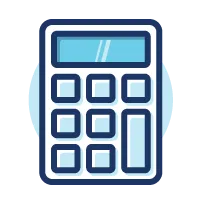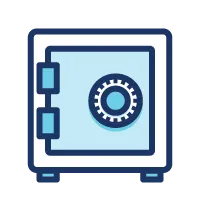What We'll Cover
- Practical steps for Gen Z to start building wealth
- How to get started in investing
- Roth IRAs and Roth 401ks
Gen Z (those born between 1997 and 2012) are starting to leave school and enter the workforce. That means Gen Z is now officially in the business of wealth building. In fact, from the time they get their first post-college or high school job until they enter retirement, building their wealth will be a part of their lives.
Many Gen Z-ers out there may be wondering how much they should be saving or what type of retirement account to invest in. If you’re part of Gen Z and looking to get started building wealth, follow these 7 wealth building steps to level up your saving and building wealth game.
1. Start Saving 15% of Your Income
When it comes to knowing how much to start saving for retirement, 15% of their gross income is a goal all Gen Z workers should strive to achieve.
When a Gen Z worker starts saving 15% of their gross income, they give themselves 40-plus years of wealth building. This not only will meet their retirement goals, but more than likely will surpass their current financial goals by a longshot.
Here’s a Quick Example:
Currently, the average annual income for Gen Z is $32,500. Saving 15% of that amount requires setting aside $407 each month for retirement savings.
Next, using the average annual rate of return from S&P 500 over the past 40 years, a 25-year-old entering the workforce would end up with $2.3 million in retirement by simply saving and investing 15% of their annual income.
Note: Average rate of return for the S&P 500 over the last 40 years is 10% and age at retirement is 65 years old.
Keep in mind, this is a very low-end estimate since in the above scenario the Gen Z worker never received a raise over their 40-year career!
But What If I Can’t Do 15%?
Investing 15% of your income may be easier said than done. This may be especially true if you’re trying to save while still paying off a student loan, a mortgage, or an auto loan.
If you’re facing debt, prioritize paying it off as quickly as possible. Your greatest wealth building tool is your income and too much of your income may be going out the door in the form of interest payments rather than building wealth for your future.
Once your debt is paid off, you’ll want to build your lifestyle around your 15% retirement savings instead of building your savings around your lifestyle. A good rule of thumb is to always pay yourself first by setting aside savings and then using whatever is left over for living.
Pro Tip: If you’re not currently living on a monthly budget, then it’s time to create one. Tell your money where to go instead of wondering where it went each month.
2. Automate Your Savings and Investing
Most companies offer a 401k or other retirement account, which make it easy for Gen Z to start saving for their golden years. One of the best things about an employer’s defined contribution plan (401k, 403b, 457, TSP) is the ability to automate your savings directly from your paycheck.
When you start automating your retirement savings from your paycheck at an early age, you’ll quickly become used to living on less than you make. This in turn will result in continuous retirement savings over your entire working lifetime, which compounds over time and builds wealth.
However, if you’re a freelancer, part of the gig-economy, or don’t have a defined contribution plan through your current employer, you can still automate your retirement savings each month from your checking account.
This will require a lot more discipline since the money you’re using to save for your future retirement is also sitting in your checking account right before it’s transferred over to your investment account. You will have to remain steadfast and fight the urge to buy more stuff with the money and instead send it to your IRA or Roth IRA.
3. Get the Company Match (Free Money)
Did you know that 98% of 401k plans have some sort of company match where employers will match up to a certain amount of whatever you save into your retirement account?
However, 17.5 million Americans did not take advantage of the company match from their 401k plan in 2021, according to CNBC. In other words; 17.5 million Americans did not take advantage of free money in 2021!
Now, let’s be clear that the company match is actually part of your total compensation package. Therefore, if you’re not taking part in the company match, then instead of getting free money, you’re actually giving your employer a raise!
Always take advantage of your employer’s company match. If you’re not sure how the company match works, contact your HR department to understand how much you need to save to get the full company match.
4. Roth IRA or Roth 401k
Tax-advantaged accounts like a 401k and a Roth 401k are either tax-deferred or tax-exempt.
Tax-deferred accounts such as a 401k, 403b, 457f, TSP, or traditional IRA provide an upfront tax break. This can be in the form of paycheck contributions to your 401k which offer an immediate tax benefit because they’re taken out before taxes or through a tax deduction with a traditional IRA when you file your tax return.
Tax-deferred doesn’t mean you’ll never pay taxes, it just means you are pushing back the taxes on your savings to when you withdraw the money in retirement.
On the other hand, tax-exempt accounts including a Roth IRA or a Roth 401k, operate differently than a tax-deferred account.
Instead of making contributions before your money is taxed, these contributions are made with after-tax dollars. Since you’re not getting a tax break on the front end, the alternative is your investments will grow tax-free and be withdrawn tax-free in retirement as well. This is why Roth IRAs and Roth 401ks are considered tax-exempt.
To keep it simple, whenever you see the word Roth, remember you’re paying taxes now and not in retirement. However, if you don’t see Roth, then you’re making tax-deferred contributions now and will pay taxes later in retirement when you withdraw your money.
Why a Roth IRA or a Roth 401k?
One is not better than the other and it’s important to simply understand why there are the two options.
First off, it’s necessary to look back at history and understand the state of the economy in the early 1980s when the 401k gained popularity. According to TaxPolicyCenter.org, income tax rates in the late 1970s and early 1980s were much higher than they are today.

Photo Credit: Tax Policy Center
Therefore, workers were looking for strategies to avoid paying higher taxes during those higher tax bracket years and were waiting to pay lower taxes later in retirement when their income was less.
However, fast forward to today and the income tax rates look much different than they did 40 years ago. With that said, many workers are choosing to pay taxes today through a Roth IRA or Roth 401k to take advantage of tax-free withdrawals in retirement when income taxes could possibly go higher.
5. Triple Tax Savings with Health Savings Account
According to a report from Fidelity, an average retired couple age 65 will need $315,000 saved for healthcare expenses in 2022. As you can imagine, this amount could drastically increase by the time a Gen Z worker enters retirement age.
One of the best ways to prepare for the high-cost of health care during retirement is to utilize a health savings account (HSA).
Health savings accounts are very unique because they offer the best of both worlds when it comes to a tax-advantaged account.
How Does a Health Savings Account Work?
Unlike a 401k or a Roth IRA, health savings accounts are both tax-deferred AND tax-exempt when used for qualified medical expenses.
Tax-deferred
contributions
Similar to a 401k, the money you save into a health savings account is tax-deferred. If your employer offers an HSA, then you may have the option to save with tax-free contributions into an HSA just as you would with a 401k. If not, then the money contributed to your HSA will be tax-deductible when you file your tax return.
Tax-free
growth
You also have the option to take the savings inside your health savings account and invest it into stocks, bonds, mutual funds, or exchanged traded funds (ETFs). These investments also grow tax-free.
Tax-free
withdrawals
When using the savings inside your HSA for qualified medical expenses, your withdrawals are also tax-free. This functions very similarly to a Roth IRA or Roth 401k.
As you can see, when used for medical expenses, you get triple tax-savings — meaning you never pay taxes on the money saved into an HSA.
If you’re employed, contact your employer and ask them if they have an HSA plan and if the employer contributes money toward the HSA on the employee’s behalf (free money)! If you’re self-employed, you can still open your own HSA on the open market.
Note: To qualify for a health savings account (HSA), you will need to be covered under a high deductible health plan (HDHP).
6. Don’t Overcomplicate Things
Life is complicated, but building wealth doesn’t have to be. Too many people put it off because they think it’s too difficult to understand or they think it takes too much time.
Instead, keep it simple by just getting started with your retirement savings either through paycheck deductions, or using an IRA or Roth IRA if you’re self-employed.
When it comes to choosing investments based on those available to you inside your employer sponsored plan, contact your employer sponsored provider for more information. Often times your employer sponsored investment company will offer free webinars or teaching material to help you get started.
On the other hand, if you’re self-employed and need more assistance, find a trusted advisor in your area that is focused on teaching you how to get started instead of selling you on how to get started.
7. Think Long Term
Generation Z is the first generation to only know a world of high-speed internet, Amazon same-day delivery, on-demand movies, and online dating. In other words, Gen Z has only known a world where things happen in a blink of an eye.
While all these technological advancements have helped society move faster, it has also made us all more impatient than ever. It’s always a good reminder that even with all the changes and advancements we have seen over the past 25 years, building wealth still takes time.
There will be days, months, and even years where it feels like your investments are going in the wrong direction. You may feel like the little bit you’re investing today won’t make much difference in the long run. And there will definitely be days when building wealth feels very slow and even boring.
When those feelings or fears start creeping in, it’s important to look back at history to see how resilient the U.S. stock market has been over both the good and bad years of building wealth.
The key to successfully building wealth is to remember you won’t build wealth tomorrow, next week, next month or even next year. Think long term and continually chip away at your wealth building goal over time…even if it takes a long time.
Key Takeaways
- Prioritize paying off debt before saving money to build wealth.
- Always take advantage of your employer’s company match.
- One of the best ways to prepare for the high cost of health care during retirement is to utilize a health savings account (HSA).
Chris “Peach” Petrie is the founder of Money Peach. Money Peach partnered with OneAZ to provide free financial education to members across the state. To learn more about OneAZ’s partnership with Money Peach, click here.
APR = Annual Percentage Rate















